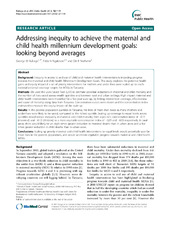| dc.contributor.author | Ruhago, George M. | en_US |
| dc.contributor.author | Ngalesoni, Frida | en_US |
| dc.contributor.author | Norheim, Ole Frithjof | en_US |
| dc.date.accessioned | 2013-05-20T12:19:44Z | |
| dc.date.available | 2013-05-20T12:19:44Z | |
| dc.date.issued | 2012-12-27 | eng |
| dc.Published | BMC Public Health 2012, 12:1119 | eng |
| dc.identifier.issn | 1471-2458 | |
| dc.identifier.uri | https://hdl.handle.net/1956/6636 | |
| dc.description.abstract | Background: Inequity in access to and use of child and maternal health interventions is impeding progress towards the maternal and child health Millennium Development Goals. This study explores the potential health gains and equity impact if a set of priority interventions for mothers and under fives were scaled up to reach national universal coverage targets for MDGs in Tanzania. Methods: We used the Lives Saved Tool (LiST) to estimate potential reductions in maternal and child mortality and the number of lives saved across wealth quintiles and between rural and urban settings. High impact maternal and child health interventions were modelled for a five-year scale up, by linking intervention coverage, effectiveness and cause of mortality using data from Tanzania. Concentration curves were drawn and the concentration index estimated to measure the equity impact of the scale up. Results: In the poorest population quintiles in Tanzania, the lives of more than twice as many mothers and under-fives were likely to be saved, compared to the richest quintile. Scaling up coverage to equal levels across quintiles would reduce inequality in maternal and child mortality from a pro rich concentration index of −0.11 (maternal) and −0.12 (children) to a more equitable concentration index of −0,03 and −0.03 respectively. In rural areas, there would likely be an eight times greater reduction in maternal deaths than in urban areas and a five times greater reduction in child deaths than in urban areas. Conclusions: Scaling up priority maternal and child health interventions to equal levels would potentially save far more lives in the poorest populations, and would accelerate equitable progress towards maternal and child health MDGs. | en_US |
| dc.language.iso | eng | eng |
| dc.publisher | BioMed Central | eng |
| dc.relation.ispartof | <a href="http://hdl.handle.net/1956/11926" target="blank"> Economic evaluation and equity impact analysis of interventions for maternal and child health in Tanzania. Evidence for fair and efficient priority setting </a> | eng |
| dc.rights | Attribution CC BY | eng |
| dc.rights.uri | http://creativecommons.org/licenses/by/2.0/ | eng |
| dc.title | Addressing inequity to achieve the maternal and child health millennium development goals: looking beyond averages | en_US |
| dc.type | Peer reviewed | |
| dc.type | Journal article | |
| dc.description.version | publishedVersion | en_US |
| dc.rights.holder | Copyright 2012 Ruhago et al.; licensee BioMed Central Ltd. | |
| dc.identifier.doi | https://doi.org/10.1186/1471-2458-12-1119 | |
| dc.identifier.cristin | 1018666 | |
| dc.source.journal | BMC Public Health | |
| dc.source.40 | 12 | |

